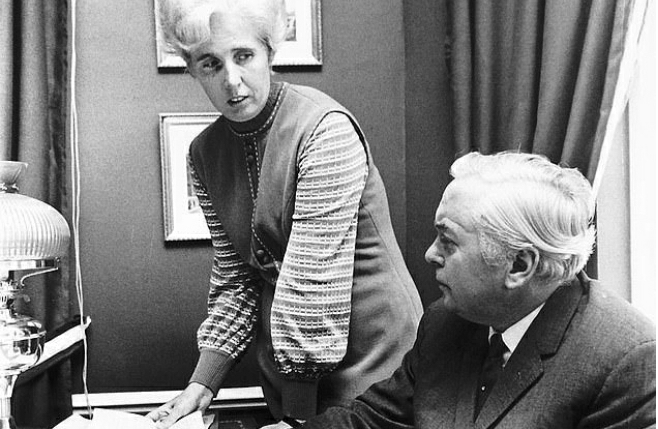RICHARD KAY: Harold Wilson, the seducer so hapless that he left his slippers under his lover's bed at Chequers

Until yesterday, the most cunning political mind of his generation had created for himself an enigmatic legacy of mystery and election-winning high intellect.
Behind the clouds of egalitarian pipe smoke and an earthy Yorkshire accent, Harold Wilson maintained a fiction that he was a happily married man, despite the swirling long-standing rumours that he had slept with his all-powerful political secretary Marcia Williams. Now, almost 50 years after he dramatically quit Downing Street, a wholly unexpected side of the former Prime Minister has emerged, ripping aside that cosy image and casting Wilson as an unlikely lothario.
In an extraordinary intervention, two of his last surviving aides —legendary press secretary Joe Haines and Lord (Bernard) Donoughue, head of No 10’s policy unit — have revealed that Wilson had an affair with a Downing Street aide 22 years his junior from 1974 until his sudden resignation in 1976.
Then Prime Minister Harold Wilson with Marcia Williams, his political secretary, preparing notes for the Labour Party conference
She was Janet Hewlett-Davies, a vivacious blonde who was Haines’s deputy in the press office. She was also married.
Yet far from revealing an unattractive seediness at the heart of government, it is instead evidence of a touching poignancy. Haines himself stumbled on the relationship when he spotted his assistant climbing the stairs to Wilson’s private quarters.
Haines said it brought his boss — who was struggling to keep his divided party united — ‘a new lease of life’, adding: ‘She was a great consolation to him.’
To Lord Donoughue, the unexpected romance was ‘a little sunshine at sunset’ as Wilson’s career was a coming to an end.
The disclosure offers an intriguing glimpse of the real Harold Wilson, a man so naively unaware of what he was doing that he left his slippers under his lover’s bed at Chequers, where anyone could have discovered them.
With her flashing smile and voluptuous figure, it was easy to see what Wilson saw in the capable Mrs Hewlett-Davies, who continued to work in Whitehall after his resignation.
But what was it about the then PM that attracted the civil servant, whose career had been steady rather than spectacular?
Haines is convinced it was love. ‘I am sure of it and the joy which Harold exhibited to me suggested it was very much a love match for him, too, though he never used the word “love” to me,’ he says.
Wilson and his wife Mary picnic on the beach during a holiday to the Isles of Scilly
Westminster has never been short of women for whom political power is an aphrodisiac strong enough to make them cheat on their husbands — but until now no one had seriously suggested Huddersfield-born Wilson was a ladies’ man. He had great charm, of course, and was a brilliant debater, but he had none of the languid confidence of other Parliamentary seducers.
For one thing, he was always the most cautious of men.
What he did possess, however, was a brain of considerable agility and, at the time of the affair which began during his third stint at No 10 in 1974, considerable domestic loneliness.
Although his marriage to Mary — the mother of his two sons — appeared strong, she did not like the life of a political wife and pointedly refused to live in the Downing Street flat.
‘Theirs was a steady rather than a happy marriage,’ one friend observed. Instead the family home was in nearby Lord North Street. But it meant that often Wilson remained alone for the night at No 10 and it was there that the affair with Mrs Hewlett-Davies began.
Yesterday Joe Haines recalled the moment when he discovered what was going on. ‘It was pure chance,’ he says. ‘I had been working late one night and all the senior staff had gone home for the evening and Downing Street was deserted. At around 9.30pm, I had gone to stretch my legs when I caught a glimpse of Janet walking across the lobby outside the Cabinet Room.
It turns out Wilson had an affair with Janet Hewlett-Davies, a vivacious blonde who was Haines’s deputy in the press office. She was also married
‘I followed her to the staircase that led up to Wilson’s room. I didn’t say anything that night but the following day I asked what she was doing there. She told me she was waiting for the Prime Minister who had asked her to wait for him there and then told me why.
‘Wilson had been delayed returning from an appointment and was surprised to find Janet still there. She said to him: “You asked me to wait for you, so I waited.” Wilson replied: “It is the first time in my life that I have been late in meeting a woman and haven’t been criticised for it.” ’
Even now, almost half a century later, Haines recognises the desperate sadness in Wilson’s plaintive observation: ‘It was clearly a reference to Marcia, who was always shouting at him and bullying him.’
Haines cannot be certain when the affair began. ‘Janet didn’t tell me how long it had been going on. She later told Harold that I knew and then he told me himself. Janet demanded nothing at all from him, he simply made her happy.’
As for Wilson, who was always so careful in all his professional relationships, Haines told me: ‘He said that: “She has made me very happy, she has given me a new lease of life.” ’
Later in 1976, at the PM’s request, Haines gave up his usual bedroom at Chequers, which adjoined Wilson’s, for Mrs Hewlett-Davies. The occasion was a farewell party Wilson was throwing for Haines who had spent seven years as his spokesman.
‘My room had a communicating door to the Prime Minister’s, and I agreed to let Janet have it. And what did Harold do? He left his slippers under her bed.’
Fact-box text
According to Haines, the affair continued after Wilson had stunned Westminster by resigning in March 1976 aged 60.
He says Mrs Hewlett-Davies visited Wilson at the grace-and-favour Oxford flat newspaper-proprietor Robert Maxwell provided for him. Like Haines, Janet had also gone on to work for the crooked Maxwell.
Both Haines and Donoughue believe that the relationship boosted Wilson’s morale in the final years of his premiership when his penchant for political manoeuvring made him too ready to suspect conspiracies against himself, whether by Cabinet colleagues or the media. It petered out after he left government.
So why choose to reveal it all these years later?
‘Bernard says it is important to the story of the last Wilson government and the forces that shaped Harold’s attitude,’ says Haines. All the same, their silence continued until Haines — again by chance — discovered that Janet had died in her sleep at her Brighton home aged 85 last October.
‘I wanted to invite her to a garden party, but I couldn’t get hold of her and that’s how I learned of her passing. Her husband was already dead.’
Wilson died aged 79 from the effects of dementia in 1995 and Mary in 2018, aged 102.
‘Telling all now seems the right moment because I decided I would not do so while either of them were still alive,’ says Haines, 96. ‘If the story had got out at the time that Harold Wilson had a mistress it would have been seriously damaging. I’m getting on a bit, so Bernard and I decided for the sake of history that we should do it.’
Not everyone is thrilled by the revelations, however. I understand Wilson’s sons, Giles and Robin, were ‘dismayed’ when they learned. For his part Haines, 96, is convinced keeping it under wraps was originally the right thing.
Although the secret has held until now, Professor Ben Pimlott, one of Wilson’s biographers, did note that Downing Street aides were jealous of his obvious affection and apparent favouritism toward Mrs Hewlett-Davies, but made no mention of an affair.
And Philip Ziegler, Wilson’s authorised biographer, did not discuss her at all. As for how the affair itself began, Haines says he asked Wilson to appoint the former journalist as his deputy after Wilson had won his first of two general elections in 1974.
‘She was calm, intelligent and didn’t lose her cool. I had known her for years when she was a local reporter. It turned out that Harold knew her from his previous administration and he was happy for me to recruit her. I have to say she never made any attempt to influence anything I did by her relationship with Wilson.’
Within a few months, the blonde aide was being described in Whitehall as ‘the new Marcia’, a notion that she was reported to have laughed at.
Born Janet Mary Hewlett in 1938, she had grown up in Shirley, Solihull, and attended Birmingham College of Commerce. Aged 18 and hoping to become a journalist, she responded to an advert for a ‘tough typist’ and became secretary to Barry Davies, who ran the Midlands News Service.
A year later she and a friend took over the business and joked she had become its ‘proprietress and managing editor’ aged just 19.
In 1964 — eight years after she became his secretary — she married Barry Davies, now working for the Ministry of Housing.
She followed him into the civil service and started a job in Downing Street in 1967, just four days before the start of the six-day war in the Middle East. Now Mrs Hewlett-Davies, she worked for two Prime Ministers, Wilson and Ted Heath.
In a newspaper article, she told of long hours, observing: ‘You work so closely together at No 10 that really no one could get away with being abrasive or having a difficult personality. And that goes for staff and Prime Ministers as well.’ She said she saw the PM, with whom she was by then having an adulterous affair, several times a day, and, pointedly, noted
that he and his wife seemed happier after they moved out of Downing Street. Mrs Hewlett-Davies was still alive when Nick Thomas-Symonds, the Labour frontbencher, wrote his history of Wilson, The Winner, in 2022 and interviewed Haines who maintained his vow of silence. ‘I was astonished by the revelations,’ he said last night.
He did, however, quote Haines on a much better-known story of Wilson’s infidelity — with Marcia Williams, whom the PM ennobled as Baroness Falkender and who drafted his notorious ‘lavender list’ of dissolution honours.
As Haines puts it: ‘Marcia told Mary Wilson on her birthday in 1972: “I went to bed with your husband six times in 1956 and it wasn’t satisfactory.” Wilson denied this vehemently to me and to his wife.’
Of Janet there was not so much as a murmur of gossip. ‘At a Paris summit she was talking to Wilson when President (Richard) Nixon passed and said jovially to Wilson: “Hello Harold, is this the blonde that you’re in trouble with?” ’
‘No,’ replied Wilson. ‘This is another one.’
Haines is convinced that had she known about the affair, Marcia would have attempted to cash in on it.
‘She was always desperate for money.’ And as he revealed she would often ‘lift or tap her ever-present handbag and say: ‘One call to the Daily Mail and he’ll be finished. I will destroy him.’
After Mr Wilson left office, Mrs Hewlett-Davies also left Downing Street to become director of information at the Department of the Environment and later at the Department of Health and Social Security.
She and her husband moved to Brighton, where they lived in a Regency townhouse in Sussex Square, a stone’s throw from the seafront.
Six years her senior, Mr Hewlett-Davies died in 2016, but she continued to enjoy visits to the theatre with friends, and worshipped at the Catholic Church of the Annunciation.
The couple did not have children and, according to Joe Haines, the marriage was ‘sexless.’
After all these years, understanding Wilson’s allure to the opposite sex is difficult. But there is something striking in the resemblance of his wife and both his lovers. All three have lively, expressive faces.
And what of Wilson who used his pipe as a symbol of dependability? The son of an industrial chemist who won an exhibition from grammar school to Jesus College, Oxford, he preferred to smoke cigars but pragmatically — some would say cynically — chose the pipe as a prop to polish his man-of-the-people credentials.
Now he emerges as a Don Juan of Westminster. Perhaps it is time he is reassessed?









0 Comments